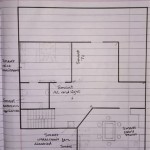Drawing house plans for free encompasses the process of creating detailed diagrams and layouts of a proposed house or building without incurring any financial costs. These plans serve as blueprints for constructing or renovating residential structures, specifying the dimensions, spatial arrangements, and material requirements for each room, level, and component.
Free house plan drawing tools and software have become increasingly accessible, empowering homeowners, builders, and architects to design and visualize their dream homes without breaking the bank. These resources offer a range of templates, customizable options, and interactive features that simplify the process, making it possible to create professional-quality plans without specialized training or expensive software.
In the following sections, we will explore the benefits, features, and best practices for drawing house plans free, empowering you to take control of your home design journey and bring your architectural vision to life.
When drawing house plans for free, there are several important points to keep in mind:
- Accuracy is paramount
- Consider scale and proportions
- Plan for functionality and flow
- Include electrical and plumbing
- Use layers for organization
- Seek feedback and iterate
- Save and backup your plans
- Enjoy the creative process
By following these guidelines, you can create free house plans that are both functional and visually appealing.
Accuracy is paramount
When drawing house plans for free, accuracy is of the utmost importance. Inaccurate plans can lead to costly mistakes during construction, such as incorrect material quantities, structural issues, and wasted time. To ensure accuracy, it is essential to:
- Use precise measurements: Measure the dimensions of your building site accurately, taking into account any slopes or variations in elevation. When measuring existing structures, use a laser measuring device or a tape measure with imperial or metric markings.
- Draw to scale: Choose an appropriate scale for your plans, such as 1/4 inch = 1 foot or 1/8 inch = 1 foot. Maintain consistency throughout your drawings to avoid errors.
- Double-check your work: Carefully review your plans for any errors or inconsistencies. Pay attention to details such as wall thicknesses, window and door sizes, and the placement of electrical and plumbing fixtures.
Accurate house plans are essential for obtaining building permits, communicating design intent to contractors, and ensuring a smooth and successful construction process.
In addition to the tips above, consider the following best practices for drawing house plans with accuracy:
- Use a grid system: A grid system can help you maintain accuracy and consistency in your drawings. Draw light grid lines on your paper or use a drafting table with a built-in grid.
- Use templates and symbols: Many free house plan drawing tools and software offer templates and symbols for common building components, such as walls, windows, and doors. These can help you save time and ensure accuracy.
- Seek professional advice: If you are unsure about any aspect of drawing house plans, consult with a professional architect or builder. They can provide guidance and ensure that your plans meet building codes and industry standards.
By following these tips, you can create accurate and reliable house plans for free, setting the foundation for a successful building project.
Consider scale and proportions
When drawing house plans for free, it is essential to consider scale and proportions to ensure that your design is realistic, functional, and aesthetically pleasing. Here are some key points to keep in mind:
- Choose an appropriate scale: The scale of your plans determines the level of detail and the overall size of your drawings. Common scales for house plans include 1/4 inch = 1 foot, 1/8 inch = 1 foot, and 1/16 inch = 1 foot. Choose a scale that allows you to fit your plans on a manageable number of sheets while still providing enough detail.
- Maintain consistent proportions: The proportions of your house plan should be consistent throughout. This means that the sizes of rooms, windows, doors, and other features should be proportional to each other. For example, the height of a room should be approximately twice its width, and the size of a window should be proportional to the size of the room it is in.
- Consider the relationship between spaces: The scale and proportions of your house plan should also consider the relationship between spaces. For example, the living room should be larger than the bedrooms, and the kitchen should be large enough to accommodate appliances and storage. The flow of traffic between rooms should also be considered, with wider hallways and doorways in high-traffic areas.
- Use reference points: When drawing house plans, it is helpful to use reference points to ensure that the scale and proportions are correct. For example, you can use a standard door or window size as a reference point to determine the size of other features in the plan.
By considering scale and proportions when drawing house plans for free, you can create a design that is both realistic and visually appealing.
In addition to the points above, here are some tips for considering scale and proportions in your house plans:
- Use graph paper: Graph paper can help you maintain accurate scale and proportions in your drawings.
- Draw to scale: Use a ruler or measuring tape to ensure that your drawings are to scale.
- Use templates and symbols: Many free house plan drawing tools and software offer templates and symbols for common building components, such as walls, windows, and doors. These can help you save time and ensure accuracy.
- Seek professional advice: If you are unsure about any aspect of drawing house plans, consult with a professional architect or builder. They can provide guidance and ensure that your plans meet building codes and industry standards.
By following these tips, you can create house plans that are accurate, well-proportioned, and ready for construction.
Plan for functionality and flow
When drawing house plans for free, it is important to consider functionality and flow to create a home that is both comfortable and efficient. Here are some key points to keep in mind:
- Consider your lifestyle: Think about how you and your family live and what your needs are. Do you need a lot of space for entertaining? Do you have small children or elderly family members who need special considerations? Consider your daily routines and how you want your home to support them.
- Create a logical layout: The layout of your house should be logical and easy to navigate. Avoid creating dead-end hallways or awkward room shapes. Consider the flow of traffic between rooms and make sure that there is a clear path from the entrance to each room.
- Use space efficiently: Make the most of every square foot by using space efficiently. Avoid wasting space on unnecessary hallways or large, empty rooms. Consider using built-in storage and multi-purpose furniture to save space.
- Provide adequate storage: Every home needs adequate storage space for clothes, linens, appliances, and other belongings. Plan for closets, pantries, and other storage areas throughout your house.
By considering functionality and flow when drawing house plans for free, you can create a home that is both comfortable and efficient, meeting the needs of your family and lifestyle.
In addition to the points above, here are some tips for planning for functionality and flow in your house plans:
- Use a bubble diagram: A bubble diagram is a sketch that shows the relationships between different spaces in your house. It can help you visualize the flow of traffic and identify potential problem areas.
- Create a space plan: A space plan is a detailed drawing that shows the layout of your house, including the size and shape of each room. It can help you fine-tune the flow of traffic and make sure that all of the spaces in your house are functional.
- Seek professional advice: If you are unsure about any aspect of planning for functionality and flow, consult with a professional architect or builder. They can provide guidance and ensure that your plans meet building codes and industry standards.
By following these tips, you can create house plans that are functional, efficient, and tailored to your specific needs.
Include electrical and plumbing
When drawing house plans for free, it is important to include electrical and plumbing plans to ensure that your home has the necessary infrastructure to function safely and efficiently. Electrical plans show the location of electrical outlets, switches, light fixtures, and other electrical components, while plumbing plans show the location of water supply lines, drains, and fixtures.
There are a few different ways to include electrical and plumbing plans in your house plans. One option is to create separate electrical and plumbing plans using specialized software or templates. Another option is to use a software program that allows you to create both electrical and plumbing plans within the same document.
Regardless of the method you choose, it is important to make sure that your electrical and plumbing plans are accurate and complete. Inaccurate or incomplete plans can lead to costly mistakes during construction, such as incorrect wiring or plumbing connections.
Here are some tips for including electrical and plumbing in your house plans for free:
- Use templates and symbols: Many free house plan drawing tools and software offer templates and symbols for common electrical and plumbing components, such as outlets, switches, light fixtures, water supply lines, and drains. These can help you save time and ensure accuracy.
- Label everything: Clearly label all of the electrical and plumbing components in your plans, including the type of component, the amperage or voltage, and the size of the pipe or wire.
- Follow code: Make sure that your electrical and plumbing plans comply with all applicable building codes and industry standards. This will help to ensure the safety and efficiency of your home.
- Seek professional advice: If you are unsure about any aspect of drawing electrical or plumbing plans, consult with a professional electrician or plumber. They can provide guidance and ensure that your plans meet code requirements.
By following these tips, you can create electrical and plumbing plans that are accurate, complete, and compliant with code. This will help to ensure that your home is safe, efficient, and comfortable.
Use layers for organization
When drawing house plans for free, it is important to use layers for organization. Layers are like sheets that can be stacked on top of each other. Each layer can contain different types of information, such as walls, windows, doors, electrical, and plumbing. Using layers helps to keep your plans organized and easy to edit.
To use layers, create a new layer for each type of information. For example, you could create a layer for walls, a layer for windows, a layer for doors, a layer for electrical, and a layer for plumbing. Once you have created your layers, you can start adding objects to each layer.
To add an object to a layer, simply select the object and then click on the layer that you want to add it to. The object will then be added to the selected layer. You can also move objects between layers by dragging and dropping them.
Using layers for organization has several benefits. First, it helps to keep your plans organized and easy to read. Second, it makes it easy to edit your plans. For example, if you want to change the location of a wall, you can simply move the wall object to a different layer. Third, using layers can help you to avoid mistakes. For example, if you have a layer for electrical and a layer for plumbing, you can be sure that the electrical and plumbing lines will not intersect.
Here are some tips for using layers for organization when drawing house plans for free:
- Use a different layer for each type of information: This will help to keep your plans organized and easy to read.
- Name your layers clearly: This will help you to identify the contents of each layer.
- Use colors to differentiate between layers: This can help you to visualize the different types of information on your plans.
- Hide layers that you are not working on: This will help to keep your plans uncluttered and easy to navigate.
By following these tips, you can use layers to organize your house plans for free, making them easier to read, edit, and avoid mistakes.
Seek feedback and iterate
Once you have created a draft of your house plans, it is important to seek feedback from others and iterate on your design. This will help you to identify and correct any errors or omissions in your plans, and to ensure that your design is functional, efficient, and aesthetically pleasing.
There are several ways to seek feedback on your house plans. You can ask friends, family members, or colleagues to review your plans and provide their feedback. You can also hire a professional architect or builder to review your plans and provide guidance.
Once you have received feedback on your plans, take the time to carefully consider it. Make changes to your plans as needed to address any concerns or suggestions. It is also important to be open to making changes to your plans even if you do not agree with all of the feedback you receive. Remember, the goal is to create the best possible house plans for your needs.
The iteration process can be repeated as many times as necessary until you are satisfied with your house plans. Once you have finalized your plans, you can then begin the process of building your dream home.
Here are some tips for seeking feedback and iterating on your house plans:
- Ask for specific feedback: When asking for feedback on your house plans, be specific about what you are looking for. For example, you could ask for feedback on the layout, the functionality, or the aesthetics of your plans.
- Be open to criticism: It is important to be open to criticism when seeking feedback on your house plans. Remember that the goal is to improve your plans, so be willing to consider changes even if you do not agree with them.
- Make changes as needed: Once you have received feedback on your house plans, take the time to carefully consider it and make changes as needed. It is important to address any concerns or suggestions that you receive.
- Repeat the process: The iteration process can be repeated as many times as necessary until you are satisfied with your house plans. There is no need to rush the process, so take your time and make sure that your plans are perfect.
By following these tips, you can seek feedback and iterate on your house plans for free, ensuring that your plans are functional, efficient, and aesthetically pleasing.
Save and backup your plans
Once you have created your house plans, it is important to save and backup your work regularly. This will help to protect your plans from being lost or damaged, and will allow you to easily access them in the future.
- Save your plans in multiple formats: Saving your plans in multiple formats will help to ensure that you can access them even if one format becomes corrupted or inaccessible. Common file formats for house plans include DWG, DXF, and PDF.
- Store your plans in multiple locations: Storing your plans in multiple locations will help to protect them from being lost or damaged in the event of a fire, flood, or other disaster. Consider storing your plans on your computer, in the cloud, and on a physical backup drive.
- Back up your plans regularly: Backing up your plans regularly will help to ensure that you have a recent copy of your work in case your computer or backup drive fails. Consider backing up your plans daily or weekly.
- Share your plans with others: Sharing your plans with others can help to protect them from being lost or damaged. Consider sharing your plans with a friend, family member, or colleague who can store them in a safe location.
By following these tips, you can save and backup your house plans for free, ensuring that your work is protected and accessible in the future.
Enjoy the creative process
Drawing house plans for free can be a rewarding and enjoyable experience. It allows you to express your creativity and design a home that perfectly meets your needs and desires. Here are a few tips for enjoying the creative process:
Start with a vision: Before you start drawing, take some time to think about what you want in a home. What are your must-have features? What kind of style do you prefer? Once you have a clear vision in mind, you can start to translate it into a design.
Experiment with different layouts: There are many different ways to lay out a house. Don’t be afraid to experiment with different options until you find one that you love. Consider the flow of traffic, the placement of windows and doors, and the overall functionality of the space.
Add personal touches: Your house should be a reflection of your personality and style. Don’t be afraid to add personal touches to your plans, such as unique architectural features, custom built-ins, or special finishes. These details will make your house feel like home.
Have fun: Drawing house plans should be an enjoyable experience. Don’t take yourself too seriously, and allow your creativity to flow. The more you enjoy the process, the better your plans will be.
By following these tips, you can enjoy the creative process of drawing house plans for free and create a home that you love.









Related Posts








